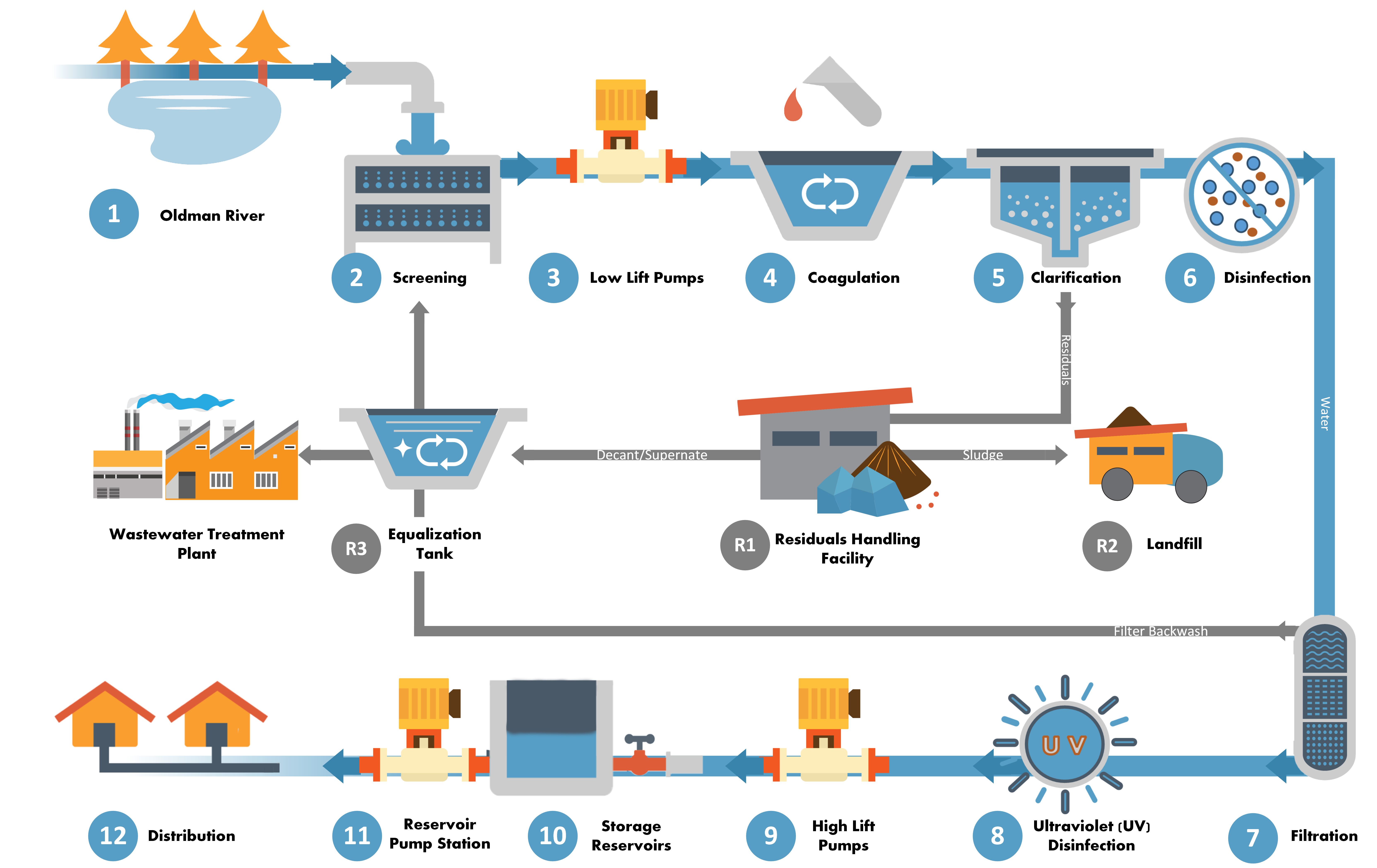Several steps are required to treat our wastewater, which has the capacity to treat 80 million litres of wastewater a day (MLD) average flow and a peak of 160 MLD.
The City collects all the wastewater that comes out of homes, schools, and businesses . The wastewater flows through the sanitary piping system by gravity and pumps to our Wastewater Treatment Plant.
1. Headworks: Screen and Grit Removal
When wastewater reaches a treatment plant, it passes through screens that remove larger materials such as plastic bags, toys, sticks, and golf balls. The wastewater then travels into grit cyclone separators where the heavier material settles to the bottom and is taken to the Waste and Recycling Center. This water, known as Primary Influent, flows by gravity to the Primary Clarifiers.
2. Primary Clarifiers
These are open-air tanks used for settling and skimming. The water stays in these tanks for about two hours. After that, more material settles at the bottom. This sludge and top skimming waste (scum) are pumped to the digesters for anaerobic (without oxygen) decomposition. The overflow from these tanks (primary effluent) goes to the secondary process for further treatment.
The treatment process is then separated into two parts:
- Liquid treatment processing: Bioreactors (BVioP), Secondary Clarifiers, Ultraviolet Disinfection (U.V.), final Effluent
- Sludge treatment processing: Digesters, Sludge as Fertilizer, Methane Gas
3. Bioreactors: Step BioP: Liquid Treatment Processing
Biological treatment processes are systems that use microorganisms to degrade organic contaminants from wastewater. The incoming secondary influent stream is split and fed stepwise to each anaerobic zone. The mixed liquor exiting the first three aerobic zones is directed to the anoxic zone of the next step in the process. Denitrified mixed liquor from the end of the anoxic zones is recycled to the corresponding anaerobic zone. After a long retention time, the mixed liquor flows to the secondary clarifiers.
4. Secondary Clarifiers: Liquid Treatment Processing
In the secondary clarifiers, which are large, open-air tanks, the mixed liquor is retained for a few hours. During this period, the activated sludge settles by gravity and the clear secondary effluent overflows the clarifiers' weirs and flows to the ultraviolet-light disinfection facility. Most of the settled activated sludge is returned to the bioreactors to repopulate it with micro-organisms. Excess activated sludge is pumped to the gravity belt thickener to remove most of the water and is then sent to the anaerobic digesters.
5. Ultraviolet Disinfection (U.V.): Liquid Treatment Processing
Effluent from the secondary clarifiers flows to the ultraviolet disinfection facility. The ultraviolet light disrupts the micro-organisms, making them incapable of reproduction and they can no longer cause disease. Ultraviolet-light disinfection, unlike chlorine, adds no harmful chemicals to the plant's final effluent.
6. Final Effluent: Liquid Treatment Processing
Final effluent flows from the ultraviolet-light disinfection facility and is discharged into the river. The final effluent consistently meets the stringent effluent standards set by Alberta Environmental Protection. The effluent is clear, colorless, , and very low in organic solids, suspended solids, phosphorus, ammonia nitrogen and pathogenic (disease-causing) micro-organisms.
7. Digesters: Sludge Treatment Processing
In the covered anaerobic digesters, the combined primary and activated sludges are digested for approximately 30 days by anaerobic bacteria (bacteria that grow only in the absence of oxygen). The naturally-occurring bacteria break down complex organic materials into simple and stable substances such as water, methane, and carbon dioxide. The digested sludge becomes less odorous and many disease causing organisms are destroyed. This biological sludge treatment process, or anaerobic digestion, is enhanced by constant mixing, using compressed digester gas, and heating to maintain digester temperature at 35 degrees Centigrade, the ideal temperature for anaerobic bacteria growth. Anaerobic digestion produces digester gas, which consists of approximately 65 per-cent methane and 35 per-cent carbon dioxide.
8. Sludge as Fertilizer: Sludge Treatment Processing
The digested sludge is applied to agricultural land as a means of disposal. Each year 6000 dry tonnes (or 90,000 cubic meters) is hauled from the city to farms as far as 30km away. The digested sludge is rich in nutrients which help improve crop yield. The amount of sludge that can be used on an individual field is carefully regulated according to provincial regulations. Excess supernatant (water) is returned to the start of the wastewater treatment process.
9. Methane Gas: Sludge Treatment Processing
The methane gas from the anaerobic digesters is used as fuel by the plant’s co-generation facility. The generators convert methane to heat and electricity for use at the plant. This significantly reduces the plants energy costs.

